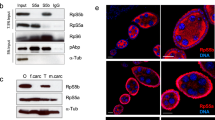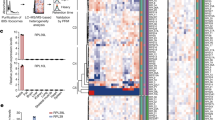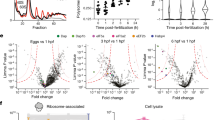Abstract
AMPHIBIAN oocytes provide very convenient material for the study of the mechanisms that control ribosomal RNA synthesis because their pattern of ribosomal RNA synthesis does not change greatly during oogenesis. During the lampbrush stage of oogenesis (stage 4) more than 97 per cent of the RNA synthesized per unit time in the oocytes is ribosomal. This happens because the genes for ribosomal RNA are specifically amplified3–5 to such an extent that the oocyte nucleus (germinal vesicle) has an rDNA content approximately 1,500 times more than the haploid amount4. On the other hand, in mature oocytes (stage 6) no ribosomal RNA is synthesized1,2, although the extra copies of the ribosomal cistrons are still present. There must therefore be a mechanism in these cells which turns off ribosomal RNA synthesis. It should also be remembered that ribosomal RNA synthesis resumes only after the embryo has reached gastrulation6,7. Furthermore, the cytoplasmic environment in the egg and in the pre-gastrula embryo is such that when nuclei from neurula endoderm cells, active in ribosomal RNA synthesis, are transplanted into enucleated eggs, they stop ribosomal RNA synthesis, although they synthesize DNA-like and soluble RNAs and are able to sustain normal development of the embryo. Ribosomal RNA synthesis in the nuclear transplanted embryos resumes only at gastrulation8. It has been suggested9,10 that this cytoplasmic control of the pattern of nuclear transcription could be mediated through a factor which specifically inhibits ribosomal RNA synthesis.
This is a preview of subscription content, access via your institution
Access options
Subscribe to this journal
Receive 51 print issues and online access
$199.00 per year
only $3.90 per issue
Buy this article
- Purchase on Springer Link
- Instant access to full article PDF
Prices may be subject to local taxes which are calculated during checkout
Similar content being viewed by others
References
Davidson, E. H., Allfrey, V. G., and Mirsky, A. E., Proc. US Nat. Acad. Sci., 52, 502 (1964).
Davidson, E. H., and Mirsky, A. E., Brookhaven Symp. Biol., 18, 77 (1965).
Evans, D., and Birnstiel, M. L., Biochim. Biophys. Acta, 166, 274 (1968).
Brown, D. D., and David, I. B., Science, 160, 272 (1968).
Gall, J. C., Proc. US Nat. Acad. Sci., 60, 553 (1968).
Brown, D. D., and Littna, E., J. Mol. Biol. ., 8, 669 (1964).
Bachvarova, R., Davidson, E. H., Allfrey, V. G., and Mirsky, A. E., Proc. US Nat. Acad. Sci., 55, 358 (1966).
Gurdon, J. B., and Brown, D. D., J. Mol. Biol., 12, 27 (1965).
Yamana, K., and Shiokawa, K., Exp. Cell Res., 44, 283 (1966).
Shiokawa, K., and Yamana, K., Dev. Biol., 16, 389 (1967).
Alberts, B. M., Amodio, F. J., Jenkins, M., and Gutman, E. D., Cold Spring Harbor Symp. Quant. Biol., 33 (1968).
Dawid, I. B., Brown, D. D., and Reeder, R. H., (in the press).
Landesman, R., and Gross, P. R., Dev. Biol., 18, 571 (1968).
Brown, D. D., and Littna, E., J. Mol. Biol., 20, 95 (1966).
Birnstiel, M. L., Cell Differentiation, Ciba Foundation Symp. (edit. by de Deuck, A. V. S., and Knight, J.), 178 (Churchill, London, 1967).
Birnstiel, M., Speirs, J., Purdom, I., Jones, K., and Loening, U. E., Nature, 219, 454 (1968).
Loening, U. E., Jones, K., and Birnstiel, M. L., J. Mol. Biol., 45, 353 (1969).
Reeder, R. H., and Brown, D. D., Lepetit Colloquium on RNA Polymerase and Transcription, Florence, Italy (North Holland, Amsterdam and London, 1969).
Dische, Z., and Borenfreund, E., Biochim. Biophys. Acta, 23, 639 (1957).
Gilbert, W., and Muller-Hill, B., Proc. US Nat. Acad. Sci., 56, 1891 (1966).
Ptashne, M., Nature, 214, 232 (1967).
Reznikoff, W. S., Miller, J. H., Scaife, J. G., and Beckwith, J. R., J. Mol. Biol., 43, 201 (1969).
Crippa, M., and Tocchini-Valentini, G. P., Nature (in the press).
Gurdon, J. B., J. Embryol. Exp. Morphol., 20, 401 (1968).
Author information
Authors and Affiliations
Rights and permissions
About this article
Cite this article
CRIPPA, M. Regulatory Factor for the Transcription of the Ribosomal Genes in Amphibian Oocytes. Nature 227, 1138–1140 (1970). https://doi.org/10.1038/2271138a0
Received:
Revised:
Issue Date:
DOI: https://doi.org/10.1038/2271138a0
This article is cited by
-
Stable nuclear activation dependent on a protein synthesised during oogenesis
Nature (1976)
-
RNA synthesis in fully-grown mouse oocytes
Nature (1976)
-
DNA-cellulose column chromatography of phosphorylated nucleolar nonhistone proteins
Molecular and Cellular Biochemistry (1976)
-
Hepatitis-associated antigen in immunofluorescence I. Interfering factors
The Histochemical Journal (1974)
-
RNA Polymerases in the Germinal Vesicle Contents of Ranapipiens Oocytes
Nature New Biology (1972)
Comments
By submitting a comment you agree to abide by our Terms and Community Guidelines. If you find something abusive or that does not comply with our terms or guidelines please flag it as inappropriate.



